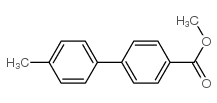Methyl 4'-methylbiphenyl-4-carboxylate
Modify Date: 2025-08-28 10:51:06

Methyl 4'-methylbiphenyl-4-carboxylate structure
|
Common Name | Methyl 4'-methylbiphenyl-4-carboxylate | ||
|---|---|---|---|---|
| CAS Number | 49742-56-5 | Molecular Weight | 226.27000 | |
| Density | 1.083 | Boiling Point | 350.1ºC at 760 mmHg | |
| Molecular Formula | C15H14O2 | Melting Point | N/A | |
| MSDS | N/A | Flash Point | 158.2ºC | |
| Name | methyl 4-(4-methylphenyl)benzoate |
|---|---|
| Synonym | More Synonyms |
| Density | 1.083 |
|---|---|
| Boiling Point | 350.1ºC at 760 mmHg |
| Molecular Formula | C15H14O2 |
| Molecular Weight | 226.27000 |
| Flash Point | 158.2ºC |
| Exact Mass | 226.09900 |
| PSA | 26.30000 |
| LogP | 3.44860 |
| Index of Refraction | 1.558 |
Synonym: Section 2 - COMPOSITION, INFORMATION ON INGREDIENTS
Risk Phrases: None Listed. Section 3 - HAZARDS IDENTIFICATION EMERGENCY OVERVIEW
Not available. Potential Health Effects Eye: May cause eye irritation. Skin: May cause skin irritation. May be harmful if absorbed through the skin. Ingestion: May cause irritation of the digestive tract. May be harmful if swallowed. Inhalation: May cause respiratory tract irritation. May be harmful if inhaled. Chronic: Not available. Section 4 - FIRST AID MEASURES Eyes: Flush eyes with plenty of water for at least 15 minutes, occasionally lifting the upper and lower eyelids. Get medical aid. Skin: Get medical aid. Flush skin with plenty of water for at least 15 minutes while removing contaminated clothing and shoes. Ingestion: Get medical aid. Wash mouth out with water. Inhalation: Remove from exposure and move to fresh air immediately. Notes to Physician: Treat symptomatically and supportively. Section 5 - FIRE FIGHTING MEASURES General Information: As in any fire, wear a self-contained breathing apparatus in pressure-demand, MSHA/NIOSH (approved or equivalent), and full protective gear. Extinguishing Media: Use water spray, dry chemical, carbon dioxide, or chemical foam. Section 6 - ACCIDENTAL RELEASE MEASURES General Information: Use proper personal protective equipment as indicated in Section 8. Spills/Leaks: Vacuum or sweep up material and place into a suitable disposal container. Section 7 - HANDLING and STORAGE Handling: Avoid breathing dust, vapor, mist, or gas. Avoid contact with skin and eyes. Storage: Store in a cool, dry place. Store in a tightly closed container. Section 8 - EXPOSURE CONTROLS, PERSONAL PROTECTION Engineering Controls: Use adequate ventilation to keep airborne concentrations low. Exposure Limits CAS# 49742-56-5: Personal Protective Equipment Eyes: Not available. Skin: Wear appropriate protective gloves to prevent skin exposure. Clothing: Wear appropriate protective clothing to prevent skin exposure. Respirators: Follow the OSHA respirator regulations found in 29 CFR 1910.134 or European Standard EN 149. Use a NIOSH/MSHA or European Standard EN 149 approved respirator if exposure limits are exceeded or if irritation or other symptoms are experienced. Section 9 - PHYSICAL AND CHEMICAL PROPERTIES Physical State: Solid Color: Not available. Odor: Not available. pH: Not available. Vapor Pressure: Not available. Viscosity: Not available. Boiling Point: Not available. Freezing/Melting Point: 115 - 116 deg C Autoignition Temperature: Not available. Flash Point: Not available. Explosion Limits, lower: Not available. Explosion Limits, upper: Not available. Decomposition Temperature: Solubility in water: Specific Gravity/Density: Molecular Formula: C15H14O2 Molecular Weight: 226.27 Section 10 - STABILITY AND REACTIVITY Chemical Stability: Not available. Conditions to Avoid: Incompatible materials. Incompatibilities with Other Materials: Strong oxidizing agents. Hazardous Decomposition Products: Carbon monoxide, carbon dioxide. Hazardous Polymerization: Has not been reported Section 11 - TOXICOLOGICAL INFORMATION RTECS#: CAS# 49742-56-5 unlisted. LD50/LC50: Not available. Carcinogenicity: Methyl 4'-methylbiphenyl-4-carboxylate - Not listed by ACGIH, IARC, or NTP. Section 12 - ECOLOGICAL INFORMATION Section 13 - DISPOSAL CONSIDERATIONS Dispose of in a manner consistent with federal, state, and local regulations. Section 14 - TRANSPORT INFORMATION IATA Not regulated as a hazardous material. IMO Not regulated as a hazardous material. RID/ADR Not regulated as a hazardous material. Section 15 - REGULATORY INFORMATION European/International Regulations European Labeling in Accordance with EC Directives Hazard Symbols: Not available. Risk Phrases: Safety Phrases: S 24/25 Avoid contact with skin and eyes. WGK (Water Danger/Protection) CAS# 49742-56-5: No information available. Canada CAS# 49742-56-5 is listed on Canada's NDSL List. CAS# 49742-56-5 is not listed on Canada's Ingredient Disclosure List. US FEDERAL TSCA CAS# 49742-56-5 is listed on the TSCA inventory. SECTION 16 - ADDITIONAL INFORMATION N/A |
| HS Code | 2916399090 |
|---|
| HS Code | 2916399090 |
|---|---|
| Summary | 2916399090 other aromatic monocarboxylic acids, their anhydrides, halides, peroxides, peroxyacids and their derivatives VAT:17.0% Tax rebate rate:9.0% Supervision conditions:none MFN tariff:6.5% General tariff:30.0% |
| 4'-methyl-biphenyl-4-carboxylic acid methyl ester |
| AMTDA027 |
| methyl 4'-methylbiphenyl-4-carboxylate |
| 4'-methyl-4-biphenylcarboxylic acid methyl ester |
| 4'-methyl-4-methoxycarbonylbiphenyl |